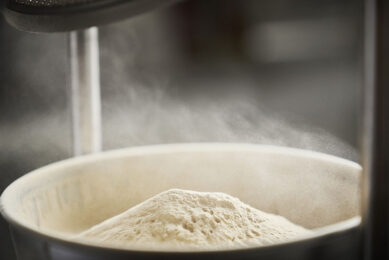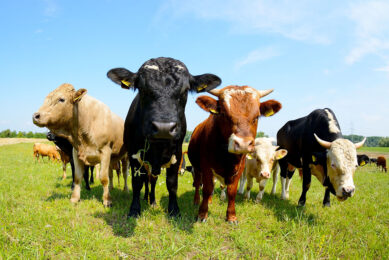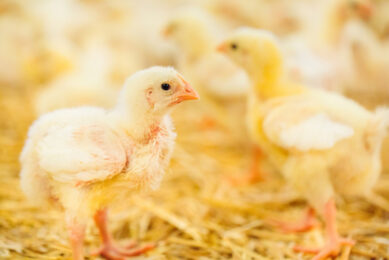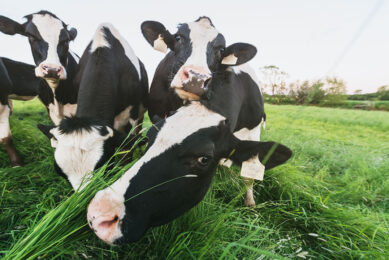Supplying organic trace minerals becomes common practice
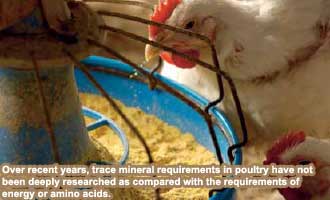
There has been an increased interest in trace mineral nutrition in recent years in modern farms. The organic form, in particular, is becoming a common practice in the feed industry today. Here we review its use for cattle, pigs and poultry.
By David González Sánchez , NOREL, S.A., Spain
Due to the great improvement and development of genetics, cows today have a higher requirement of trace minerals than their predecessors. To achieve these increased requirements, producers often feed a higher quantity of inorganic minerals. However, research has shown that twice the level of the sulphate form of copper or zinc will depress the response from the mineral. Trace minerals are involved in several body functions and biological processes such as enzymatic reactions, energy and protein metabolism, epithelial tissues growth, vitamin transport and absorption, immune system, cells repair and division, etc.
It has been proven that the addition of highly available sources of trace mineral, like chelates, can improve many parameters in diary and beef cattle: lameness, reproductive functions, milk production, antioxidant enzyme activity, weaning weights, embryonic mortality, mastitis, somatic cell counts and immune response, among others. The economic repercussion of the above mentioned problems are well known and documented.
Zinc and dairy cows
Zinc is essential for keratinisation, the healing and hardening of epithelial tissues. Keratinisation disorders prevent the hardening of hooves, which then break easily and can become deformed, besides the well-known effect of zinc improving keratin synthesis in the nipple canal. Berry and Amer (2005) calculated the cost of lameness per cow and per year to be more than €100. Lameness also reduces reproductive performance: lame cows eat less, which increases the negative energy balance; their activity is reduced, making heat detection more difficult. As a result, due to the role of zinc in anti-inflammatory processes and its effect on keratinisation of wounds, the use of highly bioavailable organic trace minerals has become generalised for preventing and treating podal problems. Corbellini (1995) observed, in a herd of 52 cows, a 43% decrease in total cases of podal diseases and a 39% decrease in relapses, on receiving a supplement with zinc methionine (Biomet Zinc) in its diet in relation to a control group.
Zinc also makes the immune system more efficient. Firstly, it is concerned with the health of the udder in the case of external bacterial attacks as an infection of the udder results in a considerable increase in the somatic cell count and affects both the amount and quality of milk. And secondly, it is concerned with the health of the animal as a whole as zinc stimulates the immune response in stressful situations. Zinc amino acid chelates are required to counteract stress, illness and inflammatory reactions. Stress in the form of mastitis and ketosis has been shown to alter zinc metabolism in dairy cattle and it is associated with a drastic decline of plasma zinc within a few hours after the process has started, and often prior to temperature rising. Edmonson and Blowley (2001) evaluated the cost of a mamitis and resulted to be more than €130 per cow per year.
The action of zinc amino acid chelates consists in favouring a quick reaction of neutrophils and increasing the integrity of skin and keratin. Pathogens are thus prevented from colonising in the udder. The results of a large number of studies and tests demonstrate that the use of zinc amino acid chelates in dairy rations reduces the count of somatic cells contained in milk by amount ranging from 20-50%. Corbellini (1995) verified a decrease of up to 40% in the count of somatic cells in a herd of heifers. Kellog (1990) demonstrated that feeding dairy cows with zinc methionine chelate resulted in both an increase (4.8%) of milk production and a lesser somatic cell count (30-50%) as compared against cows being fed a zinc oxide and methionine supplement. These results were improved in a trial carried out by Corbellini (1995), obtaining 5.4% more milk production on using Biomet Zinc. The addition of zinc amino acid chelates can have a positive economical impact for the farm: with a relative small investment (less than €5/cow/year) it is possible to significantly improve the herd’s health status, which also results in consequent economic gains. Hutjens (2005, University of Illinois) calculated that the return on investment (ratio between benefit and cost) for a zinc amino acid chelate was 14:1.
Poultry nutrition
Trace minerals in poultry nutrition have often been provided in the form of inorganic salts as they are the most economic sources. Over recent years, trace mineral requirements in poultry have not been deeply researched as compared with the requirements of energy or amino acids. However, there has been a growing interest in knowing the exact requirement of trace minerals of this specie. As a result, mineral chelates have been the focus of much research in the past few years. It has been demonstrated that feeding chelated minerals leads to higher availability compared to inorganic salt sources. Trace minerals such as zinc, manganese and copper are directly involved in bone matrix and eggshell formation. Ferket et al. (1992) observed reduced mortality and leg abnormalities in turkeys fed diets supplemented with zinc and manganese methionine chelates. Hudson et al. (2004) observed eggshell improvement leading to 3.6 extra chicks in broiler breeders at the end of the laying period when feeding zinc chelates compared to zinc sulphates. Virden et al. (2003) observed a reduction on early mortality of the chicks when zinc and manganese chelates were supplemented to broiler breeders.
Immunity
Zinc plays a very important role in animal immunity. Ferket and Qureshi (1992) found immune improvements in turkeys fed diets supplemented with zinc and manganese chelates. Kidd (1996) observed improvements in some cells functions related to disease resistance when zinc methionine chelates was supplemented in broiler and breeder feeds. Hudson et al. (2004) showed an improvement in disease resistance and the transference of antibodies to progeny when broiler breeders were fed zinc-amino acid alone or combined with zinc sulfate. The modes of action of zinc during animal immune response are related to protection against peroxidation and better cell membrane integrity. Skin scratches and other skin damages are frequent in broilers and Escherichia coli often invades the damaged skin tissue, leading to the development of cellulitis and to condemnation in poultry processing plants. When formulating diets using chelated minerals instead of inorganic sources, it is possible to reduce the total content of this minerals in the diet up to 30%. Mineral chelates provide a high and consistent availability of trace minerals, thus leading to a reduction of manure loading of these nutrients.
| What are chelates? Organic trace minerals in the form of chelates result from the reaction of a metal ion from a soluble metal salt with a specific amino acid (ligand). A chelated mineral is carried along with its bounded amino acid into the intestinal cell during absorption. The amino acid chelate it is not digested prior to absorption. It does not get dissociated in the stomach, but remains the same molecule as the one ingested and it is absorbed, due to its small size trough the membranes of the cell walls of the microvilli. Thanks to this absorption pathway we avoid interferences between mineral antagonisms, which compete for the same site of absorption in the intestinal wall. Chelates are neutral molecules (with no electrical charge) that improve the intestinal absorption of trace elements reducing the interference from agents that form insoluble complexes with ionic trace elements. Mineral amino acid chelates may be able to replace the inorganic trace minerals, thereby making possible to use lower levels of organic trace minerals in the diets to avoid high levels of mineral excretion, and therefore negative environmental impact. |
Swine nutrition
The swine sector has become more and more competitive in the recent years and good mineral nutrition is essential for profitable production. Trace minerals such as manganese, iron and zinc are essential for swine mineral nutrition as they are involved in many digestive, physiological and biological processes that directly affect fertility and health of sows and newborn pigs, and carcass quality of fattening pigs. When trace minerals are not provided in the proper levels, digestion, immune system, hormone production, bone integrity and skin health can be seriously affected. Mineral chelates incorporate into the blood steam just as they are ingested because they have a very small molecular weight (about 300 daltons) as in these molecules the metal is bounded to an amino acid. Such an incredibly low molecular weight enables ion methioninate to freely go through the placental barrier whilst iron linked to transferrin (when provided as iron sulphate) is trapped in such a barrier (Asmead, H.D. et al., 1982). The preceding statements are supported by paper published by Brady et al. of Michigan State University in 1978. Twenty sows were given 8.5 g of iron methioninate (containing 0.85 g of iron) per day during four weeks prior to farrowing. One week before farrowing the animals were given 17 g methioninate (1.7 g iron). Upon farrowing, one piglet per piglet litter was slaughtered finding higher levels of iron in liver, spleen and skeletal muscle in piglets whose mothers were fed iron methininate. These similar results were obtained in other studies comparing iron sulphate supplementation with iron methionine. Furthermore, piglets fed iron methionine had an average birth weight 10% higher than piglets fed iron sulphate. In other experiments sows supplemented with iron methionine delivered larger piglets with higher birth weight. Other papers illustrate a lower death rate of piglets born from sows that had been administered iron methionine; such results are attributed to the increase in the amount of iron transferred to the fetus through the sow’s placenta during gestation. It has been also demonstrated that supplementation of gestating sows with iron methionine prior to farrowing increases piglets’ birth weight, maintains it during periods after farrowing., and increases their level of blood haemoglobin: in brief, it prevents piglets’ iron deficiency anaemia.
Fat deposition
Several investigations have proven that liver and muscle fat is reduced by manganese supplementation. Moreover, manganese deficiency in the diet causes an excess of fat deposition in swine. This is partly due to the essential role played by manganese in fatty acid metabolism. In its absence, fat acids are not synthesised from the body adipose tissue. Where fatty acid synthesis is impaired, the remainders of dietary fat are stored as body fat instead of being used as an energy source. In fact, a clinicalsign of manganese deficiency is an increase of fat deposition. We can summarise the benefits by using manganese chelates as follows: improved feed conversation rate, enhanced carcass quality with less fat deposition, and therefore less cost per pig.
Increasing weaning weight
Zinc is involved in protein, carbohydrate, nucleotides and vitamin A metabolism. It is also necessary for bone calcification, immune system development and hormone production like testosterone, insulin and adrenal corticosteroids. Supplementation with zinc methionine chelates has shown to be effective in increasing the weaning weight of piglets and the number of piglets weaned per sow. Newly weaned pigs show better small intestine development as well as immune function when gestating and lactating sows are supplemented with zinc chelates. Providing zinc methionine chelates also increases live-born piglets, birth weight and fertility, representing a serious economic advantage in modern pig farming. AAF
Source: All About Feed Vol 1 nr 4 (2010)
caption: Over recent years, trace mineral requirements in poultry have not been deeply researched as compared with the requirements of energy or amino acids.




